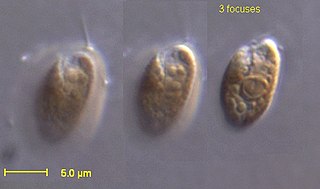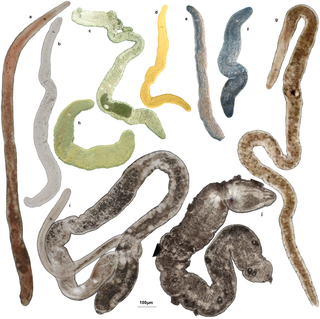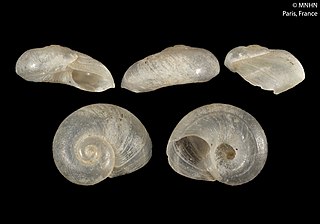
The cryptophyceae are a class of algae, most of which have plastids. About 220 species are known, and they are common in freshwater, and also occur in marine and brackish habitats. Each cell is around 10–50 μm in size and flattened in shape, with an anterior groove or pocket. At the edge of the pocket there are typically two slightly unequal flagella.

Haplochromis is a ray-finned fish genus in the family Cichlidae. It has been used as the default "wastebin taxon" for Pseudocrenilabrinae cichlids of the East African Rift, and as such became the "largest" fish "genus". Many of these cichlids are popular aquarium fishes; like similar Haplochromini they are known as "haplos", "happies" or "haps" among aquarium enthusiasts.
Mesonerilla is a genus of polychaetes in the Nerillidae family. It contains the following species:
Parhippolyte sterreri is a species of marine decapod crustacean in the family Barbouriidae, formerly placed in the genus Somersiella. It is found in marine caves around the Bahamas, Cuba and Mexico and inland anchialine caves in Bermuda.

Hesperotestudo is an extinct genus of tortoise native to North and Central America from the Early Miocene to the Late Pleistocene. Species of Hesperotestudo varied widely in size, with a large undescribed specimen from the Late Pleistocene of El Salvador reaching 150 cm (4.9 ft) in carapace length, larger than that of extant giant tortoises. Historically considered a subgenus of Geochelone, it is now considered to be distantly related to that genus. Its relationships with other tortoises are uncertain. The exposed areas of the bodies of Hesperotestudo species were extensively covered with large dermal ossicles, which in life were covered in keratin. It has been suggested that species of Hesperotestudo were relatively tolerant of cold weather. Hesperotestudo became extinct at the end of the Pleistocene roughly co-incident with the arrival of the first humans in North America. There is apparently a site in Florida where one individual may have been killed that some suggested were evidence of butchering, although others suggested that the turtle was neither cooked nor does a ledge that was found near it date at the same time as it.

Nemertodermatida is a class of Acoelomorpha, comprising 18 species of millimetre-sized turbellariform, mostly interstitial worms.

Ascopariidae is a family of flatworms.
Pseudovermis is genus of minute sea slugs, specifically aolid nudibranchs, marine gastropod mollusks or micromollusks in the family Pseudovermidae.

Cochliolepis is a genus of small sea snails, marine gastropod mollusks in the family Tornidae.

The Blissidae are a family in the Hemiptera, comprising nearly 50 genera and 400 species. The group has often been treated as a subfamily of the Lygaeidae but was resurrected as a full family by Thomas Henry (1997).

Meioglossus psammophilus is a species of acorn worm in the family Harrimaniidae, the only known species of the genus Meigolossus. It inhabits the Western Caribbean and Bermuda. The name of the species derives from two Greek words; psammon and philos which in translation means friend of the sands in reference to adult stage of species' lifestyle. The length of the species is 0.6 millimetres (0.024 in). It is able to reproduce asexually through paratomy.

Amaga is a genus of land planarians from South America.
Gigantea is a genus of land planarians from the Neotropical realm.
Ascoparia is a genus of worms belonging to the family Ascopariidae.
Haplognathiidae is a family of worms belonging to the order Filospermoidea.
Pterognathiidae is a family of worms belonging to the order Filospermoidea.
Problognathia is a monotypic genus of worms belonging to the monotypic family Problognathiidae. The only species is Problognathia minima, also known as the problematic jaw worm.
Paucidentula is a monotypic genus of worms belonging to the monotypic family Paucidentulidae. The only species is Paucidentula anonyma.
Cosmognathia is a genus of worms belonging to the family Pterognathiidae.
Pterognathia is a genus of worms belonging to the family Pterognathiidae.








